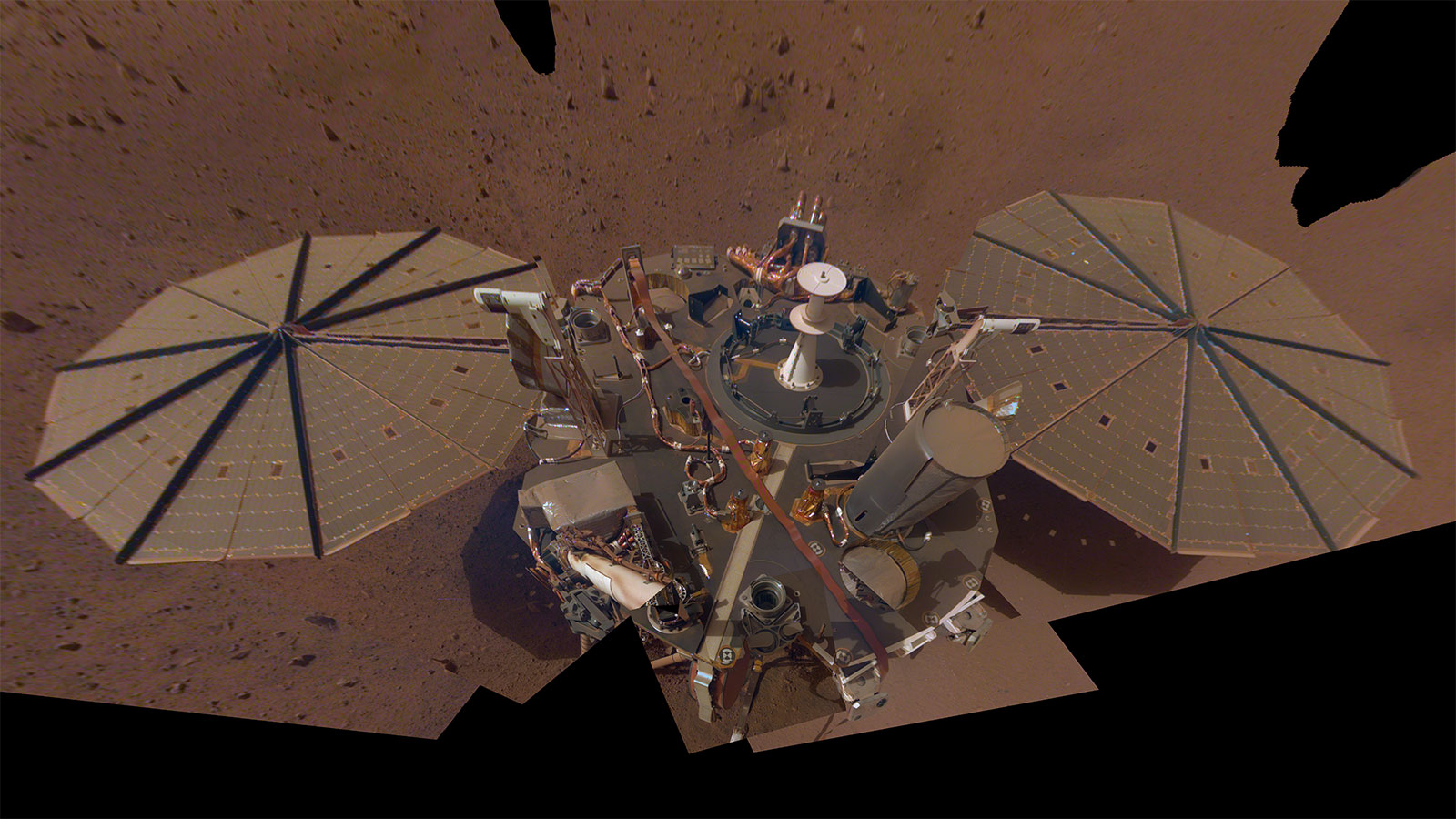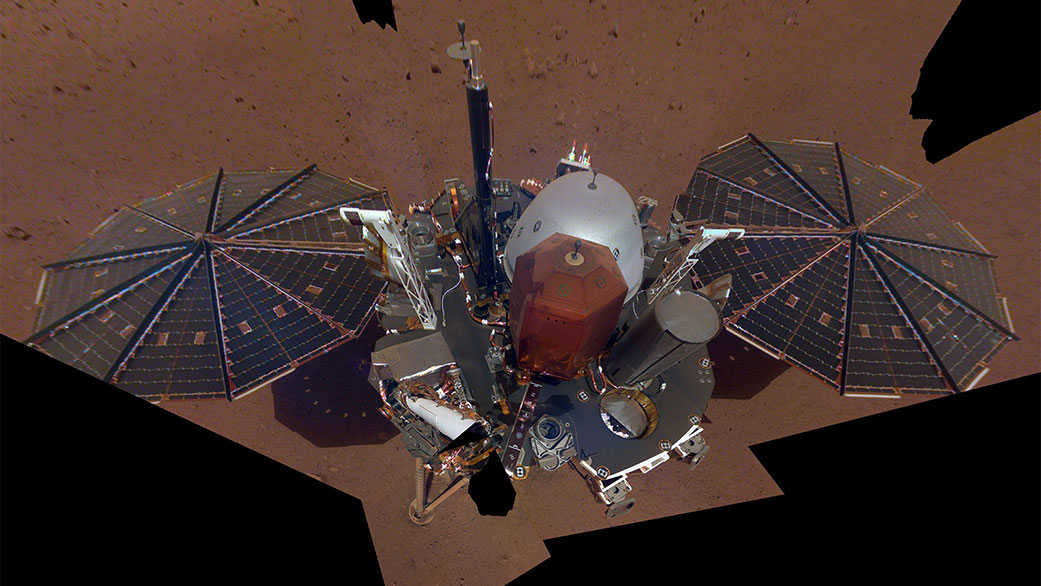The same winds that blanket Mars with dust can also blow that dust away. Catastrophic dust storms have the potential to end a mission, as with NASA’s Opportunity rover. But far more often, passing winds cleared off the rover’s solar panels and gave it an energy boost. Those dust clearings allowed Opportunity and its sister rover, Spirit, to survive for years beyond their 90-day expiration dates.
Dust clearings are also expected for Mars’ newest inhabitant, the InSight lander. Because of the spacecraft’s weather sensors, each clearing can provide crucial science data on these events, as well — and the mission already has a glimpse at that.
On Feb. 1, the 65th Martian day, or sol, of the mission, InSight detected a passing wind vortex (also known as a dust devil if it picks up dust and becomes visible; InSight’s cameras didn’t catch the vortex in this case). At the same time, the lander’s two large solar panels experienced very small bumps in power — about 0.7% on one panel and 2.7% on the other — suggesting a tiny amount of dust was lifted.
Those are whispers compared to cleanings observed by the Spirit and Opportunity rovers, where dust-clearing wind gusts occasionally boosted power by as much as 10% and left solar panels visibly cleaner. But the recent event has given scientists their first measurements of wind and dust interacting “live” on the Martian surface; none of NASA’s solar-powered rovers have included meteorological sensors that record so much round-the-clock data. In time, data from dust cleanings could inform the design of solar-powered missions as well as research on how wind sculpts the landscape.
“It didn’t make a significant difference to our power output, but this first event is fascinating science,” said InSight science team member Ralph Lorenz of Johns Hopkins University’s Applied Physics Laboratory in Laurel, Maryland. “It gives us a starting point for understanding how the wind is driving changes on the surface. We still don’t really know how much wind it takes to lift dust on Mars.”
Engineers regularly calculate a “dust factor,” a measure of how much dust is covering the panels, when analyzing InSight’s solar power. While they saw no change in dust factor around the time of this passing dust devil, they saw a clear increase in electrical current, suggesting it did lift a little bit of dust.
Key to measuring these cleanings are InSight’s weather sensors, collectively known as the Auxiliary Payload Sensor Suite, or APSS. During this first dust event, APSS saw a steady increase in wind speed and a sharp drop in air pressure — the signature of a passing dust devil.
The wind direction changed by about 180 degrees, which would be expected if a dust devil had passed directly over the lander. APSS measured a peak wind speed of 45 miles per hour (20 meters per second). But it also detected the biggest air pressure drop ever recorded by a Mars surface mission: 9 pascals, or 13% of ambient pressure. That pressure drop suggests there may have been even stronger winds that were too turbulent for sensors to record.
“The absolute fastest wind we’ve directly measured so far from InSight was 63 miles per hour (28 meters per second), so the vortex that lifted dust off our solar panels was among the strongest winds we’ve seen,” said InSight participating scientist Aymeric Spiga of the Dynamic Meteorology Laboratory at Sorbonne University in Paris. “Without a passing vortex, the winds are more typically between about 4-20 miles per hour (2-10 meters per second), depending on time of day.”
This dust lifting happened at 1:33 p.m. local Mars time, which is also consistent with the detection of a dust devil. On both Mars and Earth, the highest levels of dust devil activity are usually seen between about noon and 3 p.m., when the intensity of sunlight is strongest and the ground is hot compared with the air above it.
InSight landed on Nov. 26, 2018, in Elysium Planitia, a windy region on the Martian equator. The lander has already detected many passing dust devils, and Lorenz said it’s likely the spacecraft will see a number of large dust cleanings over the course of its two-year prime mission.
Each of InSight’s dinner-table-size solar panels has gathered a thin dust layer since landing. Their power output has fallen about 30% since then, due both to dust as well as Mars to moving farther from the Sun. Today the panels produce about 2,700 watt-hours per sol — plenty of energy for daily operations, which require roughly 1,500 watt-hours per sol.
The mission’s power engineers are still waiting for the kind of dust cleaning Spirit and Opportunity experienced. But even if they don’t see one for a while, they have ample power.
About InSight
JPL manages InSight for NASA’s Science Mission Directorate. InSight is part of NASA’s Discovery Program, managed by the agency’s Marshall Space Flight Center in Huntsville, Alabama. Lockheed Martin Space in Denver built the InSight spacecraft, including its cruise stage and lander, and supports spacecraft operations for the mission.
A number of European partners, including France’s Centre National d’Études Spatiales (CNES) and the German Aerospace Center (DLR), are supporting the InSight mission. CNES provided the Seismic Experiment for Interior Structure (SEIS) instrument to NASA, with the principal investigator at IPGP (Institut de Physique du Globe de Paris). Significant contributions for SEIS came from IPGP; the Max Planck Institute for Solar System Research (MPS) in Germany; the Swiss Federal Institute of Technology (ETH Zurich) in Switzerland; Imperial College London and Oxford University in the United Kingdom; and JPL. DLR provided the Heat Flow and Physical Properties Package (HP3) instrument, with significant contributions from the Space Research Center (CBK) of the Polish Academy of Sciences and Astronika in Poland. Spain’s Centro de Astrobiología (CAB) supplied the temperature and wind sensors.
For more information about InSight, visit:
https://mars.nasa.gov/insight/
For more information about Mars, visit:
Andrew Good
Jet Propulsion Laboratory, Pasadena, Calif.
818-393-2433
andrew.c.good@jpl.nasa.gov
2019-083
































